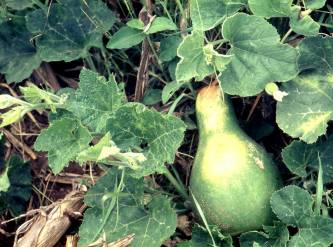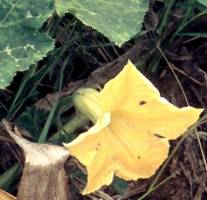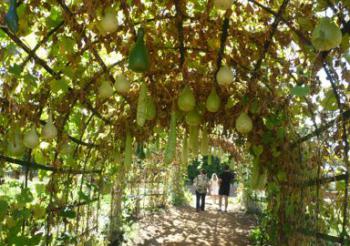Lagenaria siceraria
Lagenaria siceraria (Mol.) Standl.
Family: Cucurbitaceae
Common names: bottle gourd, calabash (Eng.); kalbas (Afr.); moraka (North Sotho); segwana (Tswana); iselwa (Xhosa, Zulu)
Introduction
The bottle gourd is one of humankind's first domesticated plants, providing food, medicine and a wide variety of utensils and musical instruments.

Description
Description
Vigorous annual herb. Stems prostrate or climbing, angular, ribbed, thick, brittle, softly hairy, up to 5 m long, cut stems exude no sap. Leaves simple, up to 400 mm long and 400 mm broad, shortly and softly hairy, broadly egg-, kidney- or heart-shaped in outline, undivided, angular or faintly 3-7-lobed, lobes rounded, margins shallowly toothed, crushed leaves non-aromatic. Leaf stalks up to 300 mm long, thick, often hollow, densely hairy, with two small, lateral glands inserted at the leaf base. Tendrils split in two.

Flowers stalked (female flower stalks shorter than male), solitary, monoecious (male and female flowers on the same plant); petals 5, crisped, cream or white with darker veins, pale yellow at the base, obovate, up to 45 mm long, opening in the evenings, soon wilting. Fruit large, variable, up to 800 x 200 mm, subglobose to cylindrical, flask-shaped or globose with a constriction above the middle; fleshy, densely hairy to ultimately glabrous, indehiscent, green, maturing yellowish or pale brown, pulp drying out completely on ripening, leaving a thick, hard, hollow shell with almost nothing inside except the seeds. Seeds many, embedded in a spongy pulp, 7-20 mm long, compressed, with two flat facial ridges, in some variants rather irregular and rugose.
Distribution and habitat
Distribution description
It is generally accepted that L. siceraria (previously known as L. vulgaris Ser.) is indigenous to Africa and that it reached temperate and tropical areas in Asia and the Americas about 10 000 years ago, with human help or probably as a wild species whose fruits had floated across the seas. Fruits are known to float in the sea for many months without the seeds losing their viability. Independent domestications from wild populations are believed to have occurred in both the Old and New Worlds. African and American land races (subsp. siceraria ) are morphologically distinct from Asian land races (subsp. asiatica). It is uncertain if the seemingly spontaneous populations in Africa are truly wild. However, it is possible that Mary Wilkins-Ellert discovered an unusual free-living plant of L. siceraria in a remote region of southeastern Zimbabwe fairly recently (Decker-Walters et al. 2004). In southern Africa, L. siceraria has been collected in Namibia, Botswana, Swaziland and the Limpopo, North-West and Gauteng provinces of South Africa. Most, if not all of these collections probably are from cultivated plants or plants that escaped from cultivation.
The calabash has been found growing mainly on alluvial sandy soil and red loam, on flat areas and moderate slopes, on rocky ridges, on river banks and in dry river beds, in disturbed areas and close to the road, often in the shade. It is common in riverine thickets, but also in woodland and savanna with Acacia, Colophospermum mopane, Faidherbia albida and Phragmites. It can also be found in cultivated lands with Sorghum and maize.
Derivation of name and historical aspects
History
The genus name Lagenaria comes from lagena, the Latin name for a Florence flask; referring to the fruit of L. siceraria. The species name siceraria probably also refers to the fruit which is useful when it is mature and dry (siccus).
The Cucurbitaceae consists of about 120 genera and 735 species that are cosmopolitan in mostly tropical and subtropical countries. Many species are cultivated and of economic importance as food plants such as cucumber, melon, pumpkin and watermelon. Members of this family are annual or perennial herbs or shrubs (only one species is a tree). The leaves are alternate and variable and tendrils are almost always present. The flowers are mostly unisexual and white or yellow; they occur on the same plant (monoecious) or on separate plants (dioecious). The fruit often is an indehiscent berry (soft-shelled) or gourd (hard-shelled) with one to many, often flattened seeds. There are about 18 genera and 75 species of this family in southern Africa.
The genus Lagenaria contains six species, probably all originally Old World and mainly African. Only two species are found in southern Africa; L. siceraria and L. sphaerica.
Ecology
Ecology
In southern Africa the calabash flowers mainly in April and May and fruits mainly from April to July. In this region it grows from about 245-1 265 m above sea level, in areas with a rainfall of about 400-600 mm annually. Heiser (1997) observed that the bottle gourd flowers are pollinated at night by hawk-moths and other moth species; by day bumble bees, cucumber beetles and other insects are active. In the Americas hummingbirds are also attracted by the nectar that only the male flowers produce. He also observed that about 40 male and about 3 to 4 female flowers occur on a single plant.
Uses
Use
According to Watt & Breyer-Brandwijk (1962), human poisoning has been reported from eating the fruit, presumably of the bitter form. (As with other members of the Cucurbitaceae, e.g. Cucumis africanus, some plants of L. siceraria produce bitter, poisonous fruits and others non-bitter, edible fruits). Various medicinal uses of the leaves, fruit and seeds have been recorded from various countries, e.g. as a pectoral, an anthelmintic, a purgative and even as a headache remedy.
In southern Africa, the leaves are commonly eaten as a vegetable and are added fresh to maize porridge, or a relish is prepared from them, mixed with other plants. Dried leaves are stored for use in the lean season. The young shoots seem to be an important vegetable, unlike the young fruits that are considered by some to be a famine food. However, in some parts of southern Africa, the young, sweet and green fruit is a popular cooked vegetable, as in many parts of the world. Bitter fruits are not eaten and considered poisonous. Rood (1994) gives recipes for dishes with the young fruit of the calabash as the main ingredient. According to van Wyk & Gericke (2000), a form of small gourd with a coarse skin, is popular in southern Africa as a vegetable known as maranka / maraka, but this is actually a land race of the true squash, Cucurbita pepo.
Until about 25 years ago, South African farmers, particularly from the Ladismith District, Little Karoo, Western Cape, used to cultivate calabashes for the pipe-making industry. The necks of the young fruit were bent regularly in such a way that they grew to form the bowls of pipes. When the fruit was dry and ripe, these necks were sawn off, cleaned and exported to pipe makers overseas. It seems that these calabash pipes became very popular in foreign countries after the Anglo-Boer War, and around 1910 they were sold in the USA for up to 12 dollars. The US Dept. of Agriculture felt that these pipe bowls could be produced far more cheaply locally and in 1909 published a pamphlet detailing the cultivation of the South African pipe calabash and the preparation of these pipes.
Heiser (1979) wrote The gourd book, devoting more than half of it to L. siceraria. Numerous uses of the bottle gourd in various cultures are discussed and illustrated, even the use as penis sheaths in Papua New Guinea ! Kefalidou (2003) stated that bottle gourds were found all over the Mediterranean as early as the Bronze Age (3 rd and 2 nd millennia BC.). Containers crafted from gourds were in constant use in that region until recent times, as bottles for wine and water, dippers, salt containers, life-jackets (made of gourds tied together), and rattles. Summit & Widess (1999) wrote a book on the rich diversity of musical instruments fashioned from bottle and other gourds in many cultures in various countries. Such instruments are played even today, also in the USA.
In rural southern Africa and elsewhere in developing countries, the calabash fruit is still widely used for various kinds of household containers and utensils. Non-bitter types are used to store water, milk and beer. These calabashes and products made from them are commonly sold as ornaments at roadside stalls and curio markets.
Pedro Paulo Salles from the Univeristy of São Paulo has provided some additional information regarding the use of bottle gourds in Brazil. Here they are known as cabaça, abóbora and porongo (or purunga). He notes that they are used for the transport of foods and liquids and for the construction of a range of musical instruments, some by native tribes. They are also used in cookery, especially in the state of Minas Gerais.

Growing Lagenaria siceraria
Grow
The calabash can be grown from seed in frost-free areas. It prefers sandy or loamy soil, some shade, good rainfall or enough water. It can be treated either as a prostrate ground cover or as a climber, in which case the maturing fruit might need some support.
References
- Decker-Walters, D.S., Wilkins-Ellert, M., Chung, S.-M. & Staub, J.E. 2004. Discovery and genetic assessment of wild bottle gourd [ Lagenaria siceraria (Mol.) Standley, Cucurbitaceae] from Zimbabwe. Economic Botany 58: 501-508.
- Fairchild, D. & Collins, G.N. 1909. The South African pipe calabash. US Department of Agriculture, Bureau of Plant Industry, circular No. 41.
- Heiser, C.B. 1979. The gourd book. University of Oklahoma Press, Norman.
- Heiser, C.B. 1997. Are bottle gourds moth pollinated? Cucurbit Network News, Spring: 1.
- Jeffrey, C. 1978. Cucurbitaceae. Flora zambesiaca 4: 437-440.
- Kefalidou, E. 2003. Phormiskoi: gourd-shaped terra-cottas from the Ancient Mediterranean. Cucurbit Network News, Spring: 7.
- Meeuse, A.D.J. 1962. The Cucurbitaceae of southern Africa. Bothalia 8: 82-85.
- Rood, B. 1994. Kos uit die veldkombuis. Tafelberg, Cape Town.
- Summit, G. & Widess, J. 1999. Making gourd musical instruments : over 60 string, wind and percussion instruments, and how to play them. Sterling Publishing, New York.
- Van Wyk, B.-E. & Gericke, N. 2000. People's plants, a guide to useful plants of southern Africa. Briza Publications, Pretoria.
- Watt, J.M. & Breyer-Brandwijk, M.G. 1962. Medicinal and poisonous plants of southern and eastern Africa, edn 2. Livingstone, Edinburgh & London.
Credits
Mienkie Welman
National Herbarium, Pretoria
June 2005.
Plant Attributes:
Plant Type: Bi/Annual, Scrambler
SA Distribution: Gauteng, Limpopo, North West
Soil type: Sandy, Loam
Flowering season: Early Summer
PH: Neutral
Flower colour: White, Cream, Yellow
Aspect: Full Sun
Gardening skill: Easy
Special Features:
Horticultural zones











Rate this article
Article well written and informative
Rate this plant
Is this an interesting plant?
Login to add your Comment
Back to topNot registered yet? Click here to register.